Chimneys play a critical role in the safety and efficiency of your home’s heating system, but they are often overlooked until problems arise. Proactive chimney maintenance not only preserves your home’s value and comfort but also helps avoid costly repairs down the line. Understanding the importance of seasonal upkeep and safety checks can make all the difference in protecting your investment and your family. For those facing more serious issues, seeking out professional chimney repair services is the best way to ensure long-term reliability.
Without regular attention, minor chimney issues can quickly escalate into major hazards such as fires, carbon monoxide leaks, or even structural damage. Ensuring your chimney functions properly also supports energy efficiency, reduces indoor smoke, and keeps your home environment healthy and comfortable.
Table of Contents
Regular Inspections and Cleaning
Chimney inspections are fundamental to both safety and longevity, helping identify early warning signs such as creosote buildup, mortar deterioration, or blockages before they escalate. Annual cleaning is just as essential. Dirty chimneys cause an estimated 25,000 residential fires in the U.S. each year, resulting in extensive property damage and endangering lives. According to U.S. News, following proper fireplace and chimney safety tips, including regular inspections, professional cleanings, and safe fire practices, is key to protecting your home and family.
Types of Inspections
There are three levels of chimney inspection, ranging from visual checks (Level 1) to more invasive evaluations (Level 3) that involve removing parts of the structure. For most homeowners, a Level 1 or Level 2 inspection is sufficient. These inspections help spot common problems such as creosote accumulation or obstructions, enabling timely cleaning and repairs to prevent hazardous conditions.

Proper Burning Practices
The type of wood and your burning habits play a huge role in minimizing chimney damage. Only burn seasoned or kiln-dried wood, which has been dried for 6-12 months. Fresh or “green” wood contains high moisture and generates more smoke, which condenses as creosote along chimney walls—significantly increasing the risk of fire. Efficient burning means hotter, cleaner fires with fewer emissions and residue.
What to Avoid Burning
Never burn trash, painted wood, or glossy papers in your fireplace, as these can release dangerous toxins and contribute to rapid soot buildup. Regularly remove ashes to maintain proper airflow within the firebox, supporting complete combustion and reducing overall chimney stress.
Installing a Chimney Cap
A chimney cap is a small investment that delivers robust protection. It acts as a barrier against rain, snow, debris, and wildlife, all of which can wreak havoc on your chimney’s interior and liner. Moisture is particularly troublesome, as it can deteriorate bricks, lead to mold growth, and erode mortar joints. Caps with meshes also deter animals like birds and squirrels from nesting inside, preventing blockages or fire hazards.
Improving Efficiency and Airflow
Additionally, chimney caps help regulate airflow, improving draft efficiency and reducing backdrafts that can push smoke or harmful gases into your home. This extra layer of protection extends the lifespan of your chimney and liner, reducing costly repairs over time. For more details on the advantages and types of chimney caps available.
Monitoring for Signs of Damage
Vigilance is a homeowner’s best tool against chimney issues. Routinely check your chimney and fireplace for visible cracks, missing mortar, efflorescence (white residue), or signs of water penetration. Pay attention to any unusual odors, smoke spillage, or slow drafting, as these can indicate obstructions, liner damage, or faulty dampers. For a detailed guide on what homeowners should know about maintaining a safe and functional chimney, see this CBS News article. If you detect signs of trouble, consult a certified chimney professional right away before the issue worsens.
Potential Issues to Watch For
Some common warning signals include crumbling brickwork, rusted damper mechanisms, and flakes or bits of tile in the firebox—each a symptom that should not be ignored. Proactive monitoring, especially after heavy storms or freeze-thaw cycles, will help you spot and address issues promptly.
Professional Maintenance
While diligent homeowners can perform many checks, some repairs and cleanings are best left to professionals who possess the right tools and expertise. Certified chimney technicians have a trained eye for subtle problems masked within chimney structures, such as hidden liner cracks or improper installations. These professionals can perform advanced cleaning, install protective components, and ensure that all parts comply with local codes and insurance requirements. Establishing a relationship with a trusted chimney service provides peace of mind and ensures that your annual maintenance is handled effectively, extending your chimney’s life and performance.
Conclusion
Protecting your chimney is an ongoing responsibility that rewards your efforts with a safer, cozier home and long-term savings. Regular inspections, careful burning practices, proactive installations like chimney caps, and timely professional interventions all add up to a smart strategy for avoiding chimney damage. By following these best practices, you can enjoy your fireplace with confidence, knowing your chimney will function safely and efficiently for years to come.

